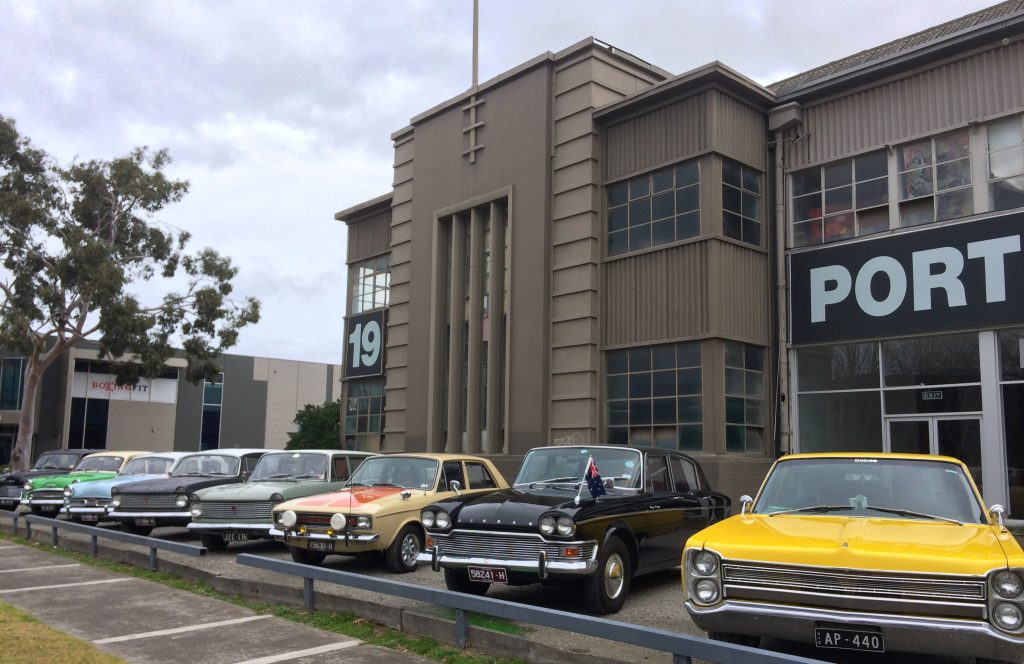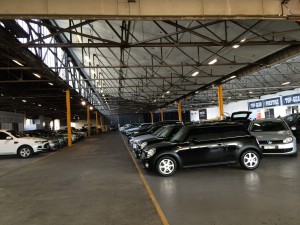Fisherman’s Bend: former Rootes car factory, and…tank research depot

The former Rootes car factory is set to be demolished. As the Age reported in June, the site will be redeveloped for townhouses. There is currently no heritage overlay on the building, which is historically significant for its associations with its respective occupation by the Department of Munitions, the Department of Aircraft Productions and then the car manufacturer Rootes Ltd. Constructed in 1941 the earliest part of the building is potentially of state level significance for its associations with the Commonwealth government’s secret tank research and development program.
Given the confidential status of the tank program, it is not surprising that little seems to be recorded of the experimental depot, but by February 1941 a tank design (designated as the Australian Cruiser, Mark 1, or AC1) had already reached mock-up stage. On 23 July 1941, a report of the Director-General of Munitions stated that this depot, occupying a 9½ acre site at Fisherman’s Bend, was half-completed.
The AWM film archive Fisherman’s Bend, Victoria 9 April 1942 shows one of the tanks outside the Salmon St building, as well as footage of demonstration trials of Australian-made armoured cars and the Cruiser Tank on nearby testing grounds.
Identified in the film are Major General L E Beavis, Master General of Ordnance; N J O Makin, Minister of Munitions; J S Beasley, Minister for Supply and Development; General Sir Thomas Blamey; General Sutherland, Chief of Staff to General MacArthur, along with Robert Menzies.
Construction of the tanks did not take place in Melbourne but rather in Sydney, where the state government railway workshops at Chullora. Ultimately, only 65 examples of the AC1 were manufactured (rather than the hundreds originally envisaged), and, although they were tested and used for training, none of them ever saw active service.
In 1945 Victoria’s Premier, John Cain, eager to have the Rootes company established in Victoria, had reportedly brought the company’s attention to a number of possible factory sites before agreement was reached to take over the premises in Salmon Street. In April 1946, Rootes Ltd officially became registered as a company in Victoria. At the time, it was reported that “details of the conversion of the wear factory to motor production were completed some time ago, in anticipation of the negotiations being successful”. With production slated to begin the following month, the company stated that it intended to manufacture its Humber, Hillman and Sunbeam-Talbot cars, along with its Commer and Karrier trucks, a rate of 6,000 to 8,000 vehicles p.a.
In 1946 the factory employed 160 people and produced 2,600 vehicles. By 1948, the number of employees had risen to 617, and the annual vehicle output increased to 3,800. Production figures had doubled by the following year, by which time the factory employed some 900 people.
An enlarged complex was officially opened on 11 August 1955 by the Governor of Victoria, Sir Dallas Brooks. By mid 1960s the factory employed 1,350 people and was producing one hundred vehicles per day. In December 1965, the firm’s Australian branch merged with rivals Chrysler Australia Ltd. Manufactured Chrysler’s own Dodge Phoenix.
The factory closed in 1972.
Today a redevelopment of the 2ha site proposes demolition of the former factory and construction of hundreds of townhouses. In 2013 The Metropolitan Planning Authority commissioned a heritage study of Fisherman’s Bend. The study has some useful history but the recommendations for heritage controls are not thorough, and it cites the need for further work. Given the threat to this building, we worked with the Art Deco and Modernism Society and Port Melbourne Historical and Preservation Society to commission a more thorough report by Simon Reeves of Built Heritage Pty: Simon Reeves Rootes Ltd Factory Final 23 July 2015.
We have asked the Minister for Planning, Richard Wynne, to apply an interim heritage control. We support retention of the administration building and a representative section of the former factory building.
At the other end of Salmon St is the General Motors Holden site. The substantial administration block built in 1936 still stands. It was sold in 2014. It has no heritage protection either.





+ There are no comments
Add yours